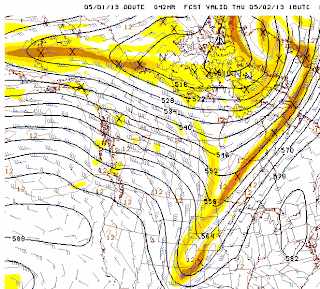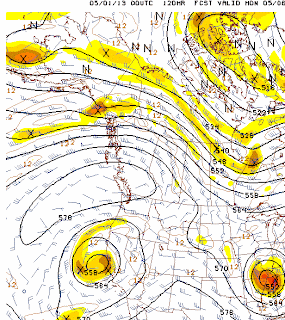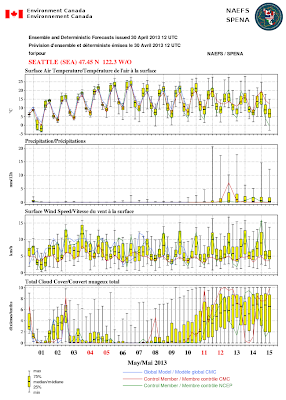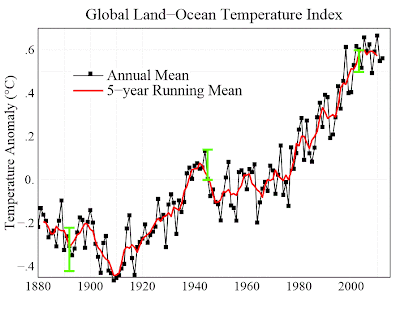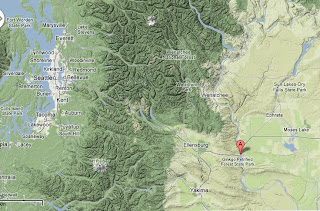The media mentions it frequently and global warming skeptics talk of little else:
the fact that global atmospheric temperatures have not gone up significantly during the past 10-15 years.
Does this disprove the idea that the planet will warm due to increased CO2 and other greenhouse gases? Are the global climate models mistaken? Who are telling the truth: the skeptics or climate scientists?
My take on all this is that a decade of near-constant temperature
does not show a fatal flaw in climate science, but it
does reveal poor communication and occasional overhyping by climate scientists. And some cynical games by skeptics.
So what is all the debate about? Here is a plot of global temperature from the NASA Goddard web site, showing the annual mean and 5-year running mean temperatures from 1880 to now (actually it shows the difference...or anomaly...from the average for 1951 to 1980). Error bars indicated by the green brackets.
Global temperatures fell to about 1910, rose to roughly 1940, leveled off for forty years, rose rapidly from 1980 to roughly 2000 and then have been nearly constant for the past 15 years. The level period during recent years is the "pause" that everyone is debating about.
The fact that temperatures level off for a several years...even a decade or more...is not surprising or exceptional, even if the earth is generally warming due to greenhouse gas increases. The atmosphere/ocean/cryosphere (ice) system has a number of modes of natural variability--in other words temperatures will vary WITHOUT any "cause" or external forcing. One example you all know about: El Nino/La Nina, which causes variations over a period of typically about 7 years. But there are others. Over the Pacific basin, there is the Pacific Decadal Oscillation, with a period of about 60 years, while the Atlantic Multidecadal Oscillation (AMO) has a period of about 70 years. And there are others.
According to most estimates, the forcing (greenhouse gas warming) by humans on the radiation coming into and out of the planet only became appreciable around 1970, and
even today natural variability is as large or larger than the human-caused warming signal. So when natural variability is pushing the atmosphere towards cooling, it can balance the global warming signal, resulting in little change. Or even temporary cooling.
There is another possible contributor to the recent leveling: the huge increase in particles (aerosols) in the atmosphere associated with the big increase in coal burning and petroleum usage in China. Such particles can cause cooling both directly (by reflecting solar radiation to space) and indirectly (by changing the number of cloud droplets).
Satellite measurement of particles in the atmosphere.
Particles from China and other sources could result in cooling that can offset greenhouse-gas warming produced by CO2 from burning fossil fuels. But quite honestly, we don't have a good handle on the amount of such particles and their impacts, both direct and indirect. We have good reason to believe that such particles result in cooling though.
Some recent articles have speculated that some of the greenhouse gas warming is going into the deep oceans and thus unavailable to heat the atmosphere. A lot of uncertainty in that hypothesis.
Some of you might ask, quite reasonably, is it possible that some of the warming during the late 20th century was not due to anthropogenic (human-caused) greenhouse warming but was the result of natural variability?
This is surely possible. In fact, a colleague of mine at the UW, K. K. Tung, and his associates have written a paper suggesting that some of the recent warming was due a natural mode of variability (the Atlantic Multi-Decadal Oscillation, see graph below). And an increasing number of studies have suggested that part of the loss of Arctic sea ice was caused by changes in atmospheric circulation, not greenhouse gas warming. So folks, one really has to be careful here.
Research by Tung and Zhou suggest that the AMO internal variability (red line) could explain some of the rapid warm up in the late 20th century and the climate pause of the last decade. It also implies that warming could be delayed a few decades.
So it is quite possible that the recent pause in warming could be traced to some combination of natural variability and particles from China and elsewhere. And that some of the warming that led to the pause may have been of natural origin. You don't see this well covered in the popular media.
A pause in the warming is good, but there is no reason to expect it to last more than a few decades. Cooling from natural variability will be replaced by warming as the natural cycle moves to a warming phase. And China will eventually have to clean up its act as it has become clear that the smoke and particles are making life miserable and unhealthy for the Chinese. And just as important:
mankind's forcing of global warming will increase as the levels of CO2 and other greenhouse gases increase in the atmosphere. And they
will increase, particularly with all the cheap/abundant gas and oil from fracking (see graphic). Emissions and concentrations of greenhouse gases will continue to rise during this century.
To put it another way, add a relatively constant level of natural variability to an increasing human-caused global warming signal, and eventually global warming will win.
Many skeptics refuse to acknowledge the basic ideas outlined above and are fixated on the "pause" or the origins of past temperature variations.
That is not the real issue here. The issue is that human-caused global warming will eventually dominate....and that will happen during the second half of the century.
But, let's face it, some of those believing in the serious nature of global warming have also been confusing the public. How many times have you seen global warming advocates crow about a single record warm year, heat wave, or a season with less ice in the arctic as clear proof of global warming? Quite often. But such transient or brief events could well be mainly the result of natural variability.
Atmospheric scientists should know about natural variability and
must be more careful in claiming that short-period extremes mean anything. And you can see the gamesmanship when they keep quiet about unusual cold periods.
Climate scientists are their own worst enemies when they show the average (or ensembles) of climate models (see below). Each climate model simulation HAS natural variability (see example below), but when you average them this variability is smoothed out, leaving a steady rise in temperature due to greenhouse gas forcing.
But such a steady rise will never occur in the real world, a real world in which lots of natural variability exists. So it looks like climate scientists have it all wrong when a period of no warming or cooling occurs for a short period. Talk about shooting oneself in the foot!
A collection of climate forecasts using global climate models are not identical due to differing natural variability in each.
And there is another issue. Most climate models have been "tuned" or calibrated to match the variations in 20th century climate. All climate models have "knobs" or the ability to change key parameters that are not well understood (like the impacts of particles in the atmosphere), and these knobs are often adjusted to match the known variation and structures of the atmosphere during the historical period with observations. The trouble is that one can overtune and actually degrade the model's ability to predict the future by doing this. For example, if a particular model did not get the cooling in the mid-20th century correctly, perhaps because it did not have the phasing of natural variability correct, a "tuning" to make it do better might change the model in a way the undermines its ability to forecast correctly in the 21st century. Such matters need to be talked about more. Fortunately, as we learn more about the atmosphere, the need for tuning has declined, but it is still an issue.

Anyway, this climate business is complicated stuff with a lot of subtleties, and folks on both "sides" have been presenting material that could be deceiving. But the bottom line is still clear,
the human-induced warming signal will increase during this century to a point that its significance and importance will be undeniable. But the magnitude of this change is still uncertain.

